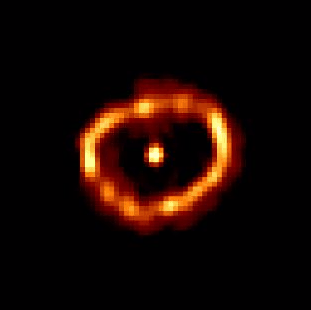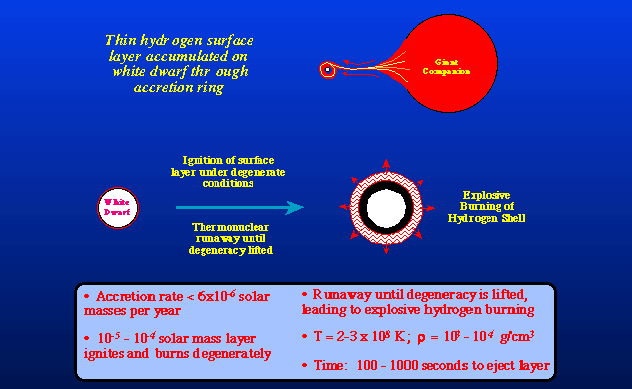2. NOVAE
|

|
|
The shell of Nova Cygni 1992. This picture was taken with the Hubble Space Telescope about two years after the nova outburst. An explosion on the surface of a white dwarf star ejected the shell, which is expanding at a velocity of about 3000 km/sec. Source: Nova Cygni 1992. |
Novae occur in binary systems containing a white dwarf. Algol might eventually become such a system. The red star in Algol may finally get rid of its entire envelope, leaving a carbon/oxygen white dwarf star behind. That would leave a binary system with a white dwarf and a main-sequence star (such as the Sirius binary system), which may remain that way for billions of years. But eventually, the main-sequence star will also run out of hydrogen in its core and begin to swell up into a red giant. When it does, it will fill its
Roche Lobe and begin to pour its outer hydrogen atmosphere back onto the white dwarf. The white dwarf star then accumulates a layer of unburned hydrogen on its surface. When about 10-8 solar masses of hydrogen has been accumulated, the temperature and pressure at the base of this layer will be great enough so that thermonuclear reactions begin. The hydrogen begins to fuse into helium. This reaction is explosive, and ejects the burning layer. The nova phenomenon is illustrated below
|

|
|
Illustration of Classical Nova. Source. |
Since the donor star has far more than 10-8 solar masses in its outer envelope, it can replenish the layer of hydrogen on the white dwarf. This may take from decades to thousands of years, depending on how fast the donor is swelling up. At any rate, novae can repeat many times as a result. As an example, check this Hubble Space Telescope observation of debris from the
recurrent nova T Pyxidis, which explodes at approximately 20-year intervals. See also Blobs in Space.
(Return to course home page)
Last modified February 19, 2000
Copyright by Richard McCray

